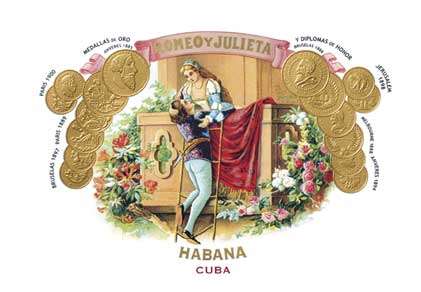Love, an intense and universal feeling, is reflected in all human expressions. And, even though the day set aside every February to celebrate it evokes all of its aspects—filial, fraternal and many others—the first association that comes to mind is the one related to perennial romantic love.
Love between a man and a woman has always been a source of inspiration for brilliant minds, which have crystallized that sentiment in ingenious, sensuous myths and paradigms enduring from ancient times to this day. One is attributed to Longo: Dafnis and Chloe; another, one of the best-known from Renaissance England, was created by William Shakespeare: Romeo and Juliet. In 1875, that youthful passion was the inspiration for Inocencio Álvarez and José García, two enterprising Spanish businessmen in Cuba, as the name for their most celebrated commercial success: the Romeo y Julieta factory and brand of cigars. Their cigar box labels (known in Spanish as habilitaciones) used excellent industrial drawings to recreate one of the most tender, symbolic scenes of love, featuring the mythical couple from Verona.
While the company founded by the two creators of the celebrated Cuban cigar (Habano) brand only lasted for a little more than a decade, the new legend had taken root, and the brand and factory attracted quite a few would-be buyers. However, it was in 1903, when José “Don Pepín” José Rodríguez Fernández of Spain, a well-known entrepreneur with extensive knowledge about cigar production and marketing, acquired the business, that the brand attained its universal celebrity. The large amount of capital that the Spaniard and his partners injected was an important factor, but above all, it was the glamour of the trademark that elevated these Habanos to the top. For example, in 1910, the factory churned out and distributed 20 million Habanos, and was considered one of the most efficient and financially strong of its time.
Romeo y Julieta cigars reached the height of fame during this time, and were sold in the most important markets of the period: the northern United States, England, France, Spain, Portugal, Switzerland and even South America, especially in Argentina and Uruguay. The Shakespearan passion continued through new followers—only this time, they were followers of the Habanos represented by the brand.
Today, Romeo y Julieta cigars are totally handmade, with leaves that come exclusively from Vuelta Abajo (PDO)2, the legendary tobacco-growing area in the western Cuban province of Pinar del Río. Their balanced, aromatic mix makes Romeo y Julieta the classic medium-flavored Habano.
The Churchill vitola, which has a galera (gallery or factory) name of Julieta No.2 (ring gauge 47), is one of the most famous, enhancing the brand’s qualities; it is a medium-flavored Habano, with an intense, very pleasant aroma.
But the theme of romantic love is not just reflected in this universal Habano brand; it has been a recurring motif since the very first commercial brands of Cuban cigars made their appearance, expressed in sets of illustrations for cigar box labels, known as habilitaciones.
These labels emerged out of the need to identify the products of each manufacturer. At first, around the 1820s, these designs were very modest, depicting only the name and address of the cigar’s maker and highlighting the city of Havana as the place of origin—which was very important, because it implied superior quality. The labels were made in different languages, depending on the final destination of the export. By the 1940s, however, an evolution in graphic expression had taken place, thanks to gradual technological developments in the industry that made these labels possible: lithography. Even though monochrome designs continued to be used in the early years, the labels became high-quality printing products featuring all types of motifs in efforts to depict the personality of the manufacturer and brand. One of these, perhaps among the least compromising of the era and at the same time among the most universal, was love between a man and a woman, depicted both explicitly, using elements such as a cupid to reinforce the idea, and implicitly, showing couples in a romantic setting.
We should note that the use of graphic themes first arose out of the need to distinguish products with visual elements; however, they were also for preventing the falsification of products identified by those labels. Therefore, the more sophisticated the labels, the more difficult they were to forge, and the more protection they provided for the Habanos they represented.
The printing industry, mother of the most beautiful Habano habilitaciones, began in black and white, but became highly developed by the late 19th century in Cuba. Many colors and techniques such as embossing and gold leaf, were used to highlight the quality of Habanos. As Cuban anthropologist Fernando Ortiz said, these cigar box labels made it possible for the Habano to acquire its “kingly vestments.” This led to sublime examples of graphic expressions of love, such as the one for the emblematic Cuban cigar brand that inspired us to write this little article.
1A term that was officially coined in 1884, when the Ley de Marcas (Brand Law) was passed in Cuba, to describe the trimmings and labels featuring industrial drawings that identified Habano products. The different labels were called Vista, Cubierta, Bofetón, Filete, Papeleta, Tapaclavo or Contraseña and Anillas. This was the first official list of habilitaciones; subsequently, the Larguero and the Costero were added.






-75x75.jpg)



